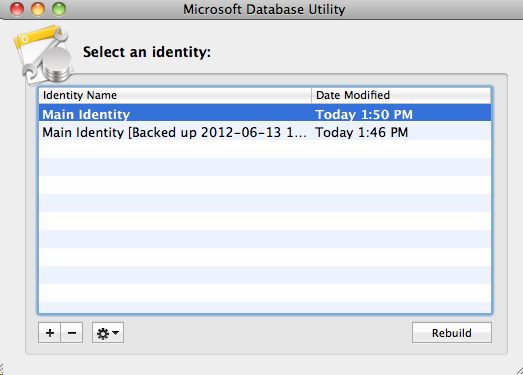
- #REBUILD THE OUTLOOK FOR MAC 2011 DATABASE MAC OS#
- #REBUILD THE OUTLOOK FOR MAC 2011 DATABASE UPDATE#
- #REBUILD THE OUTLOOK FOR MAC 2011 DATABASE SOFTWARE#
- #REBUILD THE OUTLOOK FOR MAC 2011 DATABASE TRIAL#
Generate Activity Logs – The export report of the entire recovery process is created by the tool to rebuild Outlook database Mac 2019, 2016, 2011 which can be saved in the system in CSV format. The user then receives the same data with the original structure in the resulting file.ĥ. Just check the box for Maintain folder hierarchy. Preserve Original Folder Hierarchy – During the export task, the Mac Outlook 2016 database rebuild utility maintains the original folder structure as before the export. It can be used to save emails in EML, EMLX, HTML, PDF, TXT, and MSG format.Ĥ. This function includes options such as: Automatic increment, Subject + Date (YYYY-MM-DD), etc. With this functionality, users can manage messages in a more orderly manner since they all follow a pattern of names. Option for Naming Convention – To organize emails in a more systematic way, the Mac Outlook Database Rebuild Utility offers the option of File naming convention.
#REBUILD THE OUTLOOK FOR MAC 2011 DATABASE SOFTWARE#
This feature makes this utility unique compared to other software available to users.ģ.

Users can save calendar events in ICS files separately and contacts in CSV and VCF files. It offers PST, EML, EMLX, PDF, HTML, TXT, MBOX, ICS, VCF and CSV format. In addition, the Mac Outlook 2016 Rebuild Database Utility provides 10 file formats for saving the recovered Mac Outlook data on the local system.

Export Data in 10+ Formats – After scanning the file, users can select one, more, or all of the data folders for the export job. Moreover, users can manually browse OLK and OLM files and perform recovery while keeping entire data intact.Ģ. It can automatically detect and identify the profile configured in an email application at its default location. Rebuild Outlook 365 Mac Database – This software has an option to scan all the mailbox items stored in Mac Outlook Profile/Identity. Outlook Mac Database Recovery Purchase Now Advanced Features of Mac Outlook 2016, 2011 Rebuild Database Utilityġ.
#REBUILD THE OUTLOOK FOR MAC 2011 DATABASE MAC OS#
Compatible with Mac OS 10.8, 10.9, 10,10, and Higher Versions.Save Mac Outlook Contacts in VCF / CSV Files & Calendars in ICS Format.Use Date-Filter to Export Repaired Data of Particular Date Range.Save Recovered Data in PST, EML, MBOX, HTML, PDF, MSG, EMLX, TXT, ICS, VCF and CSV.Tool to Rebuild Mac Outlook Emails, Calendar, Contacts, Notes, Tasks.Option to Browse & Repair OLK15, OLK14, and OLM Files in Bulk.Automatically Detect Profiles / Identities of Mac Outlook & Office 365.Mac Outlook Database Rebuild Utility – Prominent Features
#REBUILD THE OUTLOOK FOR MAC 2011 DATABASE TRIAL#
Download the free trial version of the application and recover 25 items / Identity/Folder/Files without paying any cost. I think I've tried something like this in the past - necessitating another rebuild.Users can try this Mac Outlook Database Rebuild Utility and effortlessly rebuild Outlook 365 database profile without losing any data. THE QUESTION: Can I go back and get the "A" TM drive, find the POP emails from September 12 to November 11 and bring them back into my machine? Some experience with this in the past leads me to believe that Outlook will not take kindly to me "inserting" emails
#REBUILD THE OUTLOOK FOR MAC 2011 DATABASE UPDATE#
Make sense?Ģ) On Novem(last Thursday) I installed an update to Mac Outlook 2011 and needed to rebuild the database upon reboot (I know, it sucks, but somehow MS can't seem to fix this issue).ģ) I suspect that it somehow used my Time Machine drive to perform that rebuild, because I have POP emails from BEFORE September 12, and AFTER November 11, but NO EMAILS from September 12 to November 11. meaning that the "A" TM drive has my TM backupsįrom September 12 to November 11.

My current TM drive is "B" and it was hooked up on November 12. 1) I use Time Machine and every 2 months I swap out the "A" TM drive with the "B" TM drive so I can always keep a fairly recent backup off-site.


 0 kommentar(er)
0 kommentar(er)
